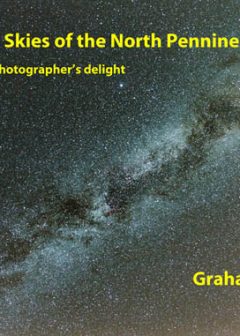The dark skies of the North Pennines: An amateur photographer’s delight
| By Graham Relf | Reviewed by David Arditti |
| Burnsiderial 2014 | vi + 95 pages |
| Price £13.50 (pbk) | ISBN:978-0-9928357-0-5 |

If you are an enthusiastic astro-imager, particularly one with an excellent dark sky site, you will soon accumulate a collection of fine images and you will wonder how best to share them. You can make your own website, you can put them on internet forums, or you can send them to the BAA. Another solution is to publish your own book of them, which is what Graham Relf has done in this attractively-produced volume.
Graham is a well-known member of the Association and an expert on image processing. He has developed a good deal of software for the Computing Section which can be found on the Section website, and his own website, grelf.net, contains information on image processing and makes his own processing software freely available. His aim in this book is clearly to do more than just produce a collection of stunning images; he also wishes to provide a step-by-step beginners’ guide to the basics of astrophotography, to provide a book that contains plenty of general information for beginners about astronomy and its history, and to advertise his location, the west of County Durham, as a great place to do astronomy.
The book is indeed nicely produced, and the images are good, though mostly of objects that will be very familiar to BAA members. My problem with it is in the confluence of objectives that Graham has set himself. It may be just my individual experience, but I find that those who wish to learn about imaging have normally acquired quite a wide general knowledge of astronomy already, and, conversely, complete beginners in astronomy do not yet know if they wish to get into the technicalities of imaging. Consequently, I can see anyone who reads this book because they want a course in astrophotography getting tired with being told such basic facts as ‘the Milky Way consists of millions of stars’, while someone who would need that information will not want to be detained by reading about ISO settings. The volume was developed from a series of talks the author has given to local societies, and I can agree that in a talk, this sort of mixture is appropriate; but for a book, I feel, a more defined objective is needed.
The book does not actually go very deeply into astro-imaging; there is, for example, no discussion of auto-guiding, and, in a panel near the end, the author states, in his sole mention of this subject, that ‘Beginners using today’s digital (non-CCD) cameras don’t really need to bother with dark or flat frames’: a most disputable assertion. Of the Rosette Nebula, he states ‘I could not pho- tograph it from suburbia… you need to be under dark skies, as in the North Pennines.’ Well actually, I (and others) have taken beautiful images of it from London. You need a light pollution filter – cheaper than moving house.
I would also take the author to task sometimes when he gets into history. William Herschel was not the first to note that the Milky Way consists of faint stars (p.2) – that was Galileo, and it is not right to describe Herschel as ‘a refugee’ (p.4) – he was a migrant. Moreover, I am very surprised that Graham makes the mistake on p.28 of imagining that ‘if we were much nearer to M42 we would see it just as in these photos’. This is a misunderstanding of optics: M42 would have the same surface brightness as seen from any distance.
This volume is not bad at the level of a book for the coffee-table for guests to peruse and stimulate interest in the stars. But I disliked the didactic style and felt the author had not thought-through at what audience it was aimed.
Dr David Arditti is a Council member of the Association and photographs the deep sky from his observatory in west London. He writes the regular planetary imaging section in Astronomy Now magazine.
| The British Astronomical Association supports amateur astronomers around the UK and the rest of the world. Find out more about the BAA or join us. |
